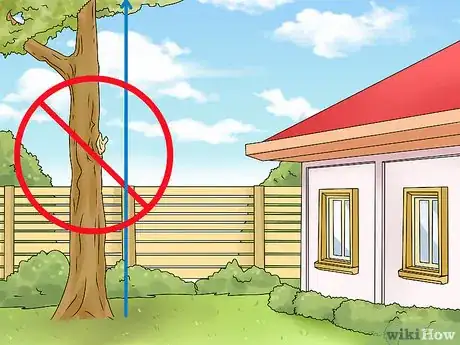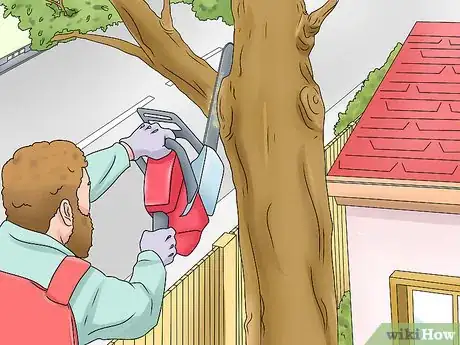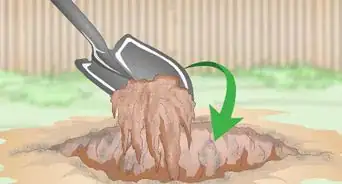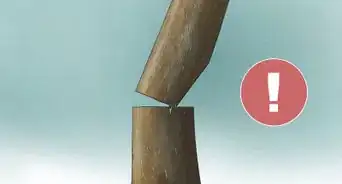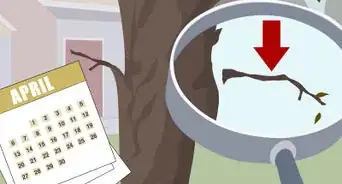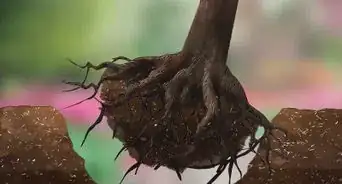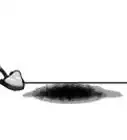This article was co-authored by Lauren Kurtz. Lauren Kurtz is a Naturalist and Horticultural Specialist. Lauren has worked for Aurora, Colorado managing the Water-Wise Garden at Aurora Municipal Center for the Water Conservation Department. She earned a BA in Environmental and Sustainability Studies from Western Michigan University in 2014.
wikiHow marks an article as reader-approved once it receives enough positive feedback. In this case, 82% of readers who voted found the article helpful, earning it our reader-approved status.
This article has been viewed 411,943 times.
Whether you are trimming and pruning your tree or removing a rotten limb, cutting a limb from a tree is easy to do if you follow the proper 3-cut technique. Make 1 partial cut on the limb close to the tree trunk, then make a second cut a little further down on the limb to remove most of the branch. Cut your tree limb a final time just outside the branch collar. Always cut the limb properly so tree stays healthy and strong all season long.
Steps
Making Your Cuts
-
1Wait until your tree is dormant in the winter to make your cuts. Pruning your tree when it's dormant gives it time to heal before threatening pests arrive. If you have particularly cold winters, wait until the coldest part of winter is over before you prune your tree.
- Pruning in the winter will also help your tree grow more during the spring.
- Avoid pruning your tree during the growing season or you could stunt its growth.
-
2Use a chainsaw, bow saw, or hand saw to make your cuts. A chainsaw will take out much of the work of chopping your tree, and is the easiest and quickest method to chop down a limb. You will have more control over your cuts using a hand or bow saw, though they will take a bit more muscle and time to cut through a thick limb.
- If you use a hand or bow saw, you will move the saw back and forth quickly to make clean, straight cuts. Make an initial mark on the tree limb, then go back and saw it off.
- If using a chainsaw, handle the machine with care and read all safety warnings on your machine before you use it. Also, make sure you wear protective eyewear and gloves.
Advertisement -
3Make a small notch in the tree limb 2–3 feet (0.61–0.91 m) from the trunk. You only need to insert your saw about 1/4 of the way through the tree. This cut helps keep the bark from splitting.[1]
- This is known as your “notch cut.”
-
4Make a second cut on the limb a little further down from your notch cut. You can move about another .5–1 foot (0.15–0.30 m) away from your first cut, and make a second cut entirely through the limb. This will remove the weight of your tree branch, so it will be easier to make your final cut.[2]
- This is called your “relief cut.”
- If you skip over this cut and go right for your final cut, you might damage the trunk and expose your tree to pests and disease.
-
5Make a final cut where the branch collar meets the rest of the tree. Make your cut with care. This is where the swollen bump of the tree meets the smooth branch section. To make a healthy cut, move your saw along the slant of the branch collar.[3]
- Sometimes the slant of the branch collar will be tricky to reach. You can make your cut from the bottom up if it is easier than going from the top down.
- Make sure your hands are not in the way of your hand saw or chainsaw.
Ensuring the Tree Heals Correctly
-
1Avoid cutting the limb too short. It used to be popular to trim the limb as close to the trunk as possible, but that actually can lead to your tree getting sick. Instead of cutting at the tree trunk, cut at the branch collar right before the tree trunk so the tree can recover easily.[4]
- Rotten holes in tree trunks and seeping wounds are caused from cutting at the branch collar.
-
2Don’t leave the tree limb too long. The branch collar will heal after the limb is removed, but if you leave the tree limb too far past the branch collar, it will heal slower. Any remaining branches or stubs will interfere with the healing process.[5]
-
3Cut your relief cuts in the right spots to avoid damaging the tree. If most of the limb’s weight is removed before trimming the branch itself, your branches may split off. This can cause major damage to your tree.[6]
- Your tree can become susceptible to disease or insect infestation if your relief cut is not made properly.
Expert Q&A
Did you know you can get expert answers for this article?
Unlock expert answers by supporting wikiHow
-
QuestionWhat time of year should Dutch Elms be cut down?
 Lauren KurtzLauren Kurtz is a Naturalist and Horticultural Specialist. Lauren has worked for Aurora, Colorado managing the Water-Wise Garden at Aurora Municipal Center for the Water Conservation Department. She earned a BA in Environmental and Sustainability Studies from Western Michigan University in 2014.
Lauren KurtzLauren Kurtz is a Naturalist and Horticultural Specialist. Lauren has worked for Aurora, Colorado managing the Water-Wise Garden at Aurora Municipal Center for the Water Conservation Department. She earned a BA in Environmental and Sustainability Studies from Western Michigan University in 2014.
Professional Gardener
-
QuestionCan I use paint or a stain to seal a cut off branch?
 Lauren KurtzLauren Kurtz is a Naturalist and Horticultural Specialist. Lauren has worked for Aurora, Colorado managing the Water-Wise Garden at Aurora Municipal Center for the Water Conservation Department. She earned a BA in Environmental and Sustainability Studies from Western Michigan University in 2014.
Lauren KurtzLauren Kurtz is a Naturalist and Horticultural Specialist. Lauren has worked for Aurora, Colorado managing the Water-Wise Garden at Aurora Municipal Center for the Water Conservation Department. She earned a BA in Environmental and Sustainability Studies from Western Michigan University in 2014.
Professional Gardener
-
QuestionI have one dying branch on my apple tree. What should I do?
 Community AnswerI would go ahead and carefully remove the dying branch. If the tree starts to die in other places, it may need to come down entirely.
Community AnswerI would go ahead and carefully remove the dying branch. If the tree starts to die in other places, it may need to come down entirely.
Things You'll Need
- Chainsaw or hand saw
- Ladder
- Safety glasses
- Gardening gloves
Warnings
- Avoid cutting more than ¼ of your tree limbs at a time. If you trim too many limbs at once, your tree can get sick.⧼thumbs_response⧽
- Never overreach with a chainsaw. If you need to make a cut above shoulder height, try using a hand saw or consulting a professional.⧼thumbs_response⧽
- Make sure to grip your chainsaw with both hands and that the area you are cutting is free of any obstructions.⧼thumbs_response⧽
- Consult with a professional if you cannot reach a tree limb without a ladder. For hard to reach limbs, it is best to hire a professional who has adequate equipment to safely remove a tree limb.⧼thumbs_response⧽
- Remove large tree limbs with care. Many large limbs are integral to the skeleton of the tree, and cutting them off could be hazardous to the health of your tree.⧼thumbs_response⧽
- Always use caution when using a saw. If you use a chainsaw, be aware that a "kickback" may occur. "Kickback" refers to the reverse force that occurs when your chainsaw's tip touches an object. Always have control of the chainsaw to prevent any injury.[8]⧼thumbs_response⧽
References
- ↑ https://youtu.be/ap1y6DGq6-w?t=4m9s
- ↑ https://www.todayshomeowner.com/video/trimming-limbs/
- ↑ https://youtu.be/TEx4uak3QQA?t=1m40s
- ↑ https://www.todayshomeowner.com/how-to-trim-large-tree-branches/
- ↑ https://www.todayshomeowner.com/how-to-trim-large-tree-branches/
- ↑ https://www.todayshomeowner.com/how-to-trim-large-tree-branches/
- ↑ https://getbusygardening.com/how-to-trim-tree-branches/
- ↑ https://www.stihl.com/p/media/download/uk-en/STIHL_Chain_Saw_Safety_Manual.pdf






